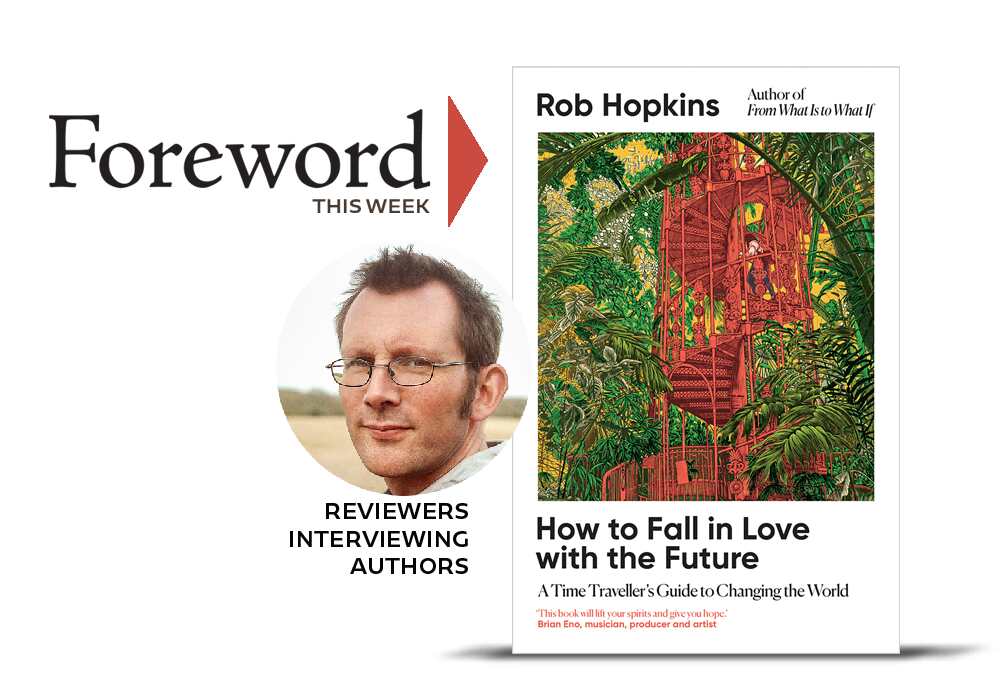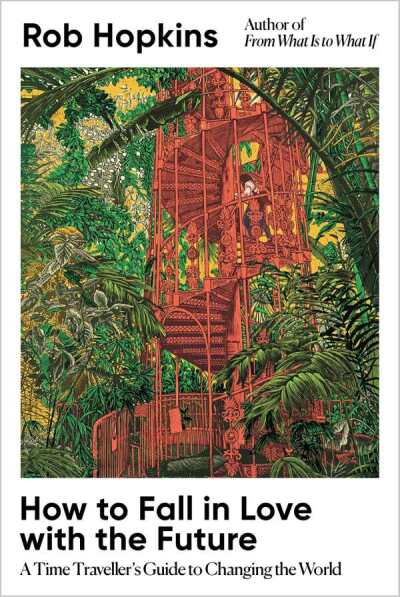Reviewer Hannah Pearson Interviews Rob Hopkins, Author of How to Fall in Love with the Future: A Time Traveller’s Guide to Changing the World

“We need to give the voice of the cynical, skeptical grouch that patrols the borders of our imagination a rest.’’—Ruha Benjamin
A splendid future is ahead if you’re only willing to imagine it using your powers of mental time travel—and no, we’re not simply talking about making predictions. Neuroscience research confirms that mental time travel taps into regions of the brain where memories as well as future projections overlap, activating a powerful cognitive process that leads directly to decision-making.

All of which is the very exciting subject of today’s conversation between reviewer Hannah Pearson and Rob Hopkins, author of How to Fall in Love with the Future. Rob points to lots of individuals and organizations doing incredibly meaningful work for the planet, which is the sort of news all of us can use right now. Enjoy the interview, and if you’re looking for more inspiring Political & Social Science projects, check out these four INDIES winners from 2024.
Your book grew out of the podcast From What If to What Next in which you and guests “time-traveled” to 2030. What inspired you to structure the book around that specific thought experiment?
In 2021 I saw a t-shirt a young woman was wearing at a Black Lives Matter protest in the US that said “I’ve been to the future. We won.” It gave me goosebumps and made me think deeply about the work I was doing. I had been asked, a few weeks later, to give a speech at Extinction Rebellion’s “The Big One” in London. I decided to give that talk, in costume, as though I was a time traveller who had just got back from a visit to 2030, and couldn’t wait to share with the audience all the amazing things he had seen there. I told them about the bicycle rush hours, the rooftop farms, the returning biodiversity, the improvements in mental health that accompanied all of this. At one point I told them “and just being able to tell you about this, about what I saw there, makes me feel really emotional.” I looked at the people closest to me and there were tears on peoples’ faces.
The idea for the book initially came out of wondering what was going on for people in that moment. What happens when we help people to create “memories of the future”? I then came across a bunch of activists, mostly in the US, mostly women of colour, like Ruha Benjamin, Rasheedah Phillips, and adrienne maree brown, whose work is based on exploring different understandings of time, on radical imagination, and on prefigurative storytelling, and I found so much inspiration in their ideas. This book emerged from my profound curiosity about bringing all of those things together.
As an imaginative exercise, mental time travel is immersive, inventive, and playful. What might you say to readers who are time travel skeptics?
In Imagination: A Manifesto, Ruha Benjamin argues that “we need to give the voice of the cynical, skeptical grouch that patrols the borders of our imagination a rest.” I mean, in terms of people who are skeptical about whether, actually, time travel is possible, people are right to be skeptical, because it’s not! Science fiction writer William Gibson once described it as “a magic on the order of kissing one’s own elbow.” The point I make in the book is what might our activism look like if we acted as if time travel were possible. As science writer James Gleick points out, time travel is “the pixie dust that helps the willing reader suspend disbelief and get through the story.” For me, why it’s so powerful is that it allows people to step out of the rigidities of the present and into what could be. We live in a time where the future is being colonised and cancelled, and that is profoundly dangerous.
What I try to do is to create multisensory spaces in which people are better able to imagine how the future could be. Between 1 and 4 percent of people have aphantasia, a condition which means people are unable to form mental images. And for some people, the idea that we might allow ourselves to imagine the future is a bit too “out there,” but what I share in the book is the many tools and techniques I’ve learned for how to help people suspend disbelief and come time travelling with me. For many people it’s a deeply touching experience.
In the book, you share examples of individuals and organizations working to build a better future or embarking on mental time travel. For instance, the Well-being of Future Generations Act in Wales requires that policymakers consider the long-term impact of any laws. How did you go about finding these examples?
I am endlessly curious about this stuff, and am always looking out for interesting stories and examples of people doing this kind of thing. In my role in the Transition movement I get to visit many interesting places and community projects, a lot of which I write about in the book. Also, people have the delightful habit of reading my books and then writing to me to tell me the things they then did that were inspired by that. For example, the story about the Bannau Brycheiniog National Park in Wales, the first local authority in the UK to build a time machine, came about from my speaking at an event in Wales where I talked about time machines and time travel, and met two women who worked for BBNP who told me about the visionary plan they’d written for the future of the park, and then three months later they wrote to me and said “we’ve built a time machine!” It’s the way I write books, I seek out people and stories, read everything I can, and then see where it all takes me.
You argue that collective imagination can inspire real innovation, such as the sliding doors in Star Trek, which predated the invention of real-life motion-activated sliding doors. What’s something that currently exists in fiction that you can foresee coming to fruition?
Great question. I am currently reading Everything for Everyone: An Oral History of the New York Commune 2052-2072, by M.E. O’Brien and Eman Abdelhadi. It’s a fascinating work of speculative fiction which is set in a post-revolutionary America. It is a collection of oral histories from different people telling their experiences of living through that time. We hear about the creation of a free and independent Palestine. We hear about the ecological restoration of large areas of the country. We hear about the building of a very different, far more equitable, post-capitalist economy. It is only by telling these stories that we keep their possibility alive in our collective imagination.
The other thing fiction can do is to tell us what we call Thrutopian stories, as in not dystopias or utopias, neither of which are that useful, but rather the stories of how we got through, stories that start right now, and tell how one person initiated something that led to something else that ended up being a catalyst for the kinds of big shifts we need to see. One great example of this is Manda Scott’s recent book Any Human Power.
Artificial intelligence is a hot topic right now. Can generative AI act as a facilitator of time travel?
I am very much a skeptic of AI, for a whole host of reasons. It is entirely possible that generative AI could be used to help this work—for example, perhaps we could have a tool that takes peoples’ photos and records their voice and then uses that to enable them to have a conversation with themselves in the near future, where their future self can tell them about all the thrilling changes that have taken place. But given the amount of energy, water, and resources AI demands, what interests me far more are the more analogue ways we can do that, harnessing the work of artists, theatre, music, the many other great tools we already have for enabling people to suspend disbelief. For example, we just built a beautiful Fortune Telling Machine, which prints you out a ticket, directly from 2030 as it happens, which describes some of what you’re doing in that future. It’s beautiful to see the anticipation people experience before they press the button, and how often the future it gives them resonates with something they are already involved in or interested in starting. And no AI used anywhere in its creation!
Can you share a little about your most recent visit to the future? Was there something new that surprised you?
I travel there quite a lot as you can imagine. I think for me the thing that is always a surprise, or rather the thing that I never get bored of seeing, is the look in many peoples’ eyes in this future. I observe in many people this strong sense of “I think we might just do this.” It’s hard to imagine from where we are in 2025, but in the very near future, the one that resulted from our doing everything we could have possibly done, there is such a tangible collective sense of possibility and excitement. It’s not the finished article, of course, but it is a world that has changed direction, a world in which emissions have fallen sharply, in line with the Paris Agreement. It’s a world where a new economy is being built, one rooted in degrowth, fairness, and equality. It’s a world where people can see mental health improving, air quality increasing, and biodiversity bouncing back. It’s a world where people are doing more meaningful work, and that mental dissonance of feeding your family through a job you know is destroying your kids’ future is no longer one that people have to live with. It feels like the unclenching of a fist. I think it’s that look of anticipation, pride and curiosity that always surprises me because in 2025 it was so hard to imagine.
Give us a glimpse into the future. What can you tell us about your next project, Field Recordings from the Future?
I’ve been working for the last couple of years with an amazing ambient music artist called Mr Kit. I was listening to a lot of ambient electronic music and some artists, such as Biosphere, use field recordings in really interesting ways. I started to wonder what it might sound like if one made music like that but the field recordings came from the future that turned out the best it possibly could have. I met Mr Kit, whose work I loved, and I started visiting places that already sound like that future: the Utrecht bicycle rush hour, the car-free neighbourhoods of Freiburg, landscapes being rewilded by beavers in Cornwall, and so on. You can find the tracks on Bandcamp, and you can also order the beautiful double vinyl edition of it there too. We have created videos for each piece and a touring immersive music and light show that will be touring in the UK next year. It’s one of my favourite projects, it’s so playful, and it’s built on Rilke’s statement that “the future must enter into you a long time before it happens.” I see much of my work at the moment as an exploration of finding as many different creative ways as possible to make that happen.
Hannah Pearson
